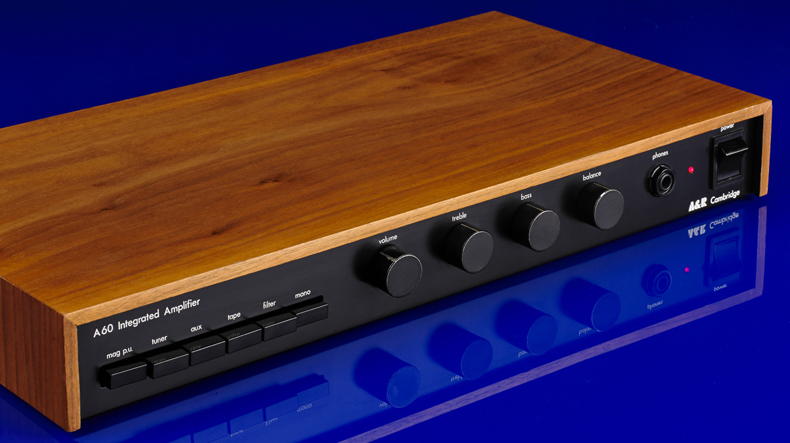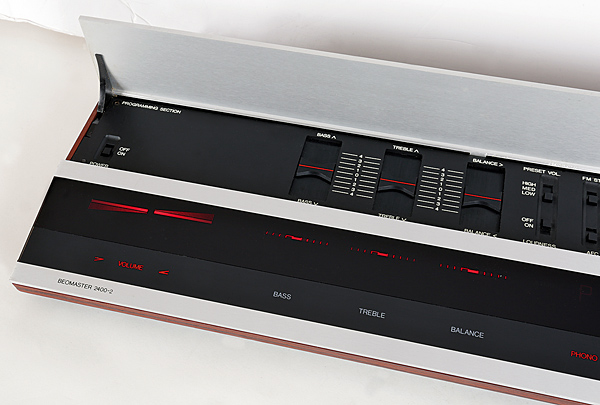The tale of the Musical Fidelity A1 design is already well-known. Tim de Paravicini accepts the challenge. “I strive to be innovative, and if I can avoid it, I don’t duplicate anybody,” he explained. “It all started with a circuit on a breadboard that I created with low feedback and that acted like a valve circuit.” He established the fundamental proportions and heatsink technologies, and the end result was a “waffle toaster form,” as he describes it. But it was genuinely a case of form following function, because the A1 looked the way it did to keep the heat at bay. “It has to deliver 20W RMS per channel while operating at temperatures below 65 degrees Celsius.”
Even for a Class A product, the A1 was a unique design. From the front end to the loudspeaker terminals, it used self-biasing and complementary output devices in a symmetrical, push-pull design. Its biassing ensured that the output could only operate at a constant current draw. Discrete op-amp designs were used for the line and phono amp circuitry. Tim claims that the 2N3055 and 2N2955 transistors from Taiwan were used “to prove a point.”
It was truly inexpensive esoterica, a high-end amplifier from a master designer housed in an imaginative and zeitgeisty aluminium shell. It was so 1980s, in a way that looked forward-thinking, courageous, and hopeful at the time. The all-black finish, together with powder blue fascia writing and a half-moon power neon, were superb finishing touches that sealed the deal.
However, living with an A1 was a bittersweet symphony. Its dependability was spotty to say the least, while it’s true that it’s been unfairly singled out — several British ‘super’ integrated models went bust all too often back in the day. The issue was that the heat within the amp steadily burnt the components over time, especially the electrolytic capacitors…
This was made worse by the fact that the A1’s side panels didn’t have any cooling slats in the first manufacturing run! According to industry rumors, later examples of the A1 had the bias lowered down, resulting in slightly less toasty cases due to the amp running in Class AB mode. Other A1s have been returned to the manufacturer for repair after their electrolytic capacitors have been cooked, only to be returned to the customer with new caps and the bias dialed down a touch. In other words, it’s difficult to overstate how near to the cutting edge the A1 was as a consumer amplifier.
Putting aside its cooling concerns, the A1’s low output power was another drawback that made it difficult to live with. It was difficult to find a modern pair of loudspeakers that could maximize the A1’s meagre 20W per side power output at the time. The statistic would have been acceptable in 1974, but it was no longer acceptable a decade later. Only real A1 devotees – and there were plenty of them – stuck with it, connecting it to all sorts of strange and fantastic, odd but highly efficient speakers. However, the need for a more powerful version arose, and Musical Fidelity’s Antony Michaelson dutifully demonstrated his ability to listen…
The redesigned A100 was released in 1985 and cost £399. “It basically had the same sound but more grunt,” says the author, describing it as “basically an A1 on steroids.” Tim explained, “I wanted this valve quality without being syrupy-stupid.” It had the same appearance as its tiny brother, but was housed in a somewhat higher casing that allowed for a chunkier power supply and dual cooling fans. By the way, unlike the A1, the case’s sides were studded with cooling holes this time around; unlike the A1, these didn’t come in a redesigned version! The new amplifier claims to deliver 50W RMS per channel into 8 ohms, which is a significant improvement over the A1 and gives it realistic, real-world loudspeaker driving capability. The only differences were a bigger power transformer with split rails and a 38V DC supply (rather than the A1’s 24V). The A100, according to Musical Fidelity, ran in 99 percent Class A, which explains the heat it produced. This is clearly more than the A1, particularly the later models.
The A100 included two slow-running 60mm 12V AC Papst cooling fans, unlike its smaller A1 brother, which was left to convection cooling. Despite the fact that these were thermostatically controlled, they struggled to maintain temperatures low. These fans are near-silent on a well-preserved A100, but hammered instances have noisy fans due to a combination of heat and the sleeve bearings drying out and/or failing. These fans, which are only marginal at best, must be in excellent working order.
Everything else, including the amplifier’s awful distortion statistics, is carried over from the A1. The good news was that they were almost all benign-sounding even-order harmonics (mostly second harmonics), the same type that gives valve amplifiers their signature warm and fluffy sound. By today’s solid-state standards, the A100 and its smaller A1 brother had low performance figures, with total harmonic distortion typically about 0.1 percent. Yet, as it does so much else so brilliantly, this is part of the mystique around this incredibly quirky amplifier.
The A100 was offered for three years or so, during which time Musical Fidelity pushed hard to repackage the circuit in various formats. The MA50, which was essentially a power amp version of the A100 without the preamplifier circuitry, was the most popular variant. It had a 36V supply and the left and right channel outputs were paralleled at the loudspeaker connections. It, too, had cooling concerns, but it wasn’t quite as wacky as the A1.
The 1980s were a wild time for hi-fi, with some truly out-of-the-box items, and this was one among them. A recapped A100 sounds fantastic, and it’s unlike anything else on the market today. Everything reported about the A100 over the years is essentially correct. Despite its unusual shape, it offers a nice tone, one that is unique and remarkably free of defects. You won’t find anything new that sounds like it — it’s the closest thing you’ll get to a solid-state valve amplifier. Tonally, it’s beautiful; the sound has a warm, velvety, sugary quality to it that gives everything you play a subtle sepia tint. However, the color does not completely dominate the audio; instead, everything is clean, sweet, and pleasant.
True, the A100 lacks a powerful bass response; the power source is assumed to be at least partly to blame for this. Give it some great eighties music to eat. The purity of Green Gartside’s vocals, as well as the nicer-than-real handling of the drum machine’s hi-hat cymbal patterns, are striking on Scritti Politti’s Perfect Way. The deep, heavy bassline, on the other hand, is texturally pleasing but lacks the grip and definition of a Mission Cyrus 2/PSX at the time. Instead, you get a rich, tuneful tone that sounds more like a good tube amp than a solid-state amp.
The midband is where this amplifier shines, and you’ll quickly realize that this is where most music’s action takes place. If you feed it some vintage REM, like Fall On Me, this vibrant and forward-sounding mix gets slightly gentrified and given more license to wander. Indeed, for the price, this amplifier has a fantastic spatial quality, placing the vocals dead center and slightly back, with all the surrounding instruments put even further back. On a Cyrus 2/PSX of the same vintage, the track comes off as far more aggressive and upfront, but musically deficient.
Essentially, the Musical Fidelity A100 has a distinct sound – one that is buttery smooth, syrupy sweet, and somewhat strong. The midband, on the other hand, is what most people notice; it has exceptional clarity, detail, and instrumental separation. Overall, it’s as near to a good valve amplifier as a solid-state amp can go – even in terms of operating temperature. Expect to pay roughly £500 for a nice one, and then be shocked at how you achieved such a polished sound for such a low price.
The Musical Fidelity A1 and its brothers have a negative reputation when it comes to purchasing, but it’s crucial to be fair here. They were significantly more affordable than their design suggested; you could argue they were expensive things created cheaply, or at the very least built to a budget. This opened up a wider market for truly exotic sound, but it also made them less reliable than most Class AB competitors. To be fair, Musical Fidelity didn’t create these amplifiers to last 35 years – nor did any other manufacturer – so we shouldn’t be too harsh. That’s why, when purchasing an A100, you should examine both its overall condition and any previous servicing it may have received – and obtain the greatest deal you can.
In the case of the A100, this means you’ll need an amp with quiet cooling fans, as it gets hotter than a bandana on a glam-metal guitarist in the 1980s. These are no longer available, and finding clear alternatives is difficult, thus they’re crucial. After that, everything else should be rather easy to fix. Any amp this old will need to be recapped at some point, and the more it does, the lighter and less forceful the bass will sound. Although they cannot replace noisy cooling fans, my favorite historic amplifier restoration company, Amplifier Repair Services (www.amprepairservices.co.uk), can do this for under £200, which is fantastic value. This not only improves the amplifier’s long-term reliability, but it also improves the sound quality, as the original device used low-cost capacitors that can now be easily replaced.
Disintegration of the rotary source selector, which can occur with excessive use, is another concern. Also, debris in the volume control’s contact track can make it noisy; a dab of Servisol contact cleaner usually solves this. Because the preamp’s audio signal passes through the tape monitor, if the contacts on this switch are filthy, the sound will deteriorate – it’s best to bypass it. Finally, the black paint can scratch the case; if it needs to be repainted, use VHT-type heat resistant paint. Once you’ve completed this, you’ll have something absolutely unique by any standard — true inexpensive esoterica.







